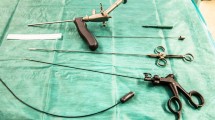Abstract
Introduction
Asymptomatic pilonidal sinus disease (PSD) discovered incidentally is regarded as a precursor of symptomatic disease, which is characterized by intradermal hair eliciting an inflammatory reaction. We aimed to investigate whether asymptomatic PSD already shows inflammation, though clinically inapparent, or represents a ‘virgin’ sinus.
Materials and methods
One thousand seven hundred and thirty-one medical records of patients presenting with primary PSD, which underwent surgery, were analysed to identify patients with surgically resected incidental PSD.
Results
Acute purulent pilonidal disease was seen in 514 of 1,731, whereas chronic fistulating pilonidal disease was the most common diagnosis group with 1,019 of 1,731 (58.9%). One hundred and forty-three of 1,731 (8.3%) patients had a previous chronic remitting pilonidal sinus. A total of 55 (3.2%) patients with clinically asymptomatic PSD were identified. Histological workup documented hair in 64.6% (1,119/1,731), with comparable rates between 68% and 71% in chronic fistulating disease, chronic remitting disease and incidental PSD (p = 0.80). Inflammation was found in 53 of 55 (96.4%) incidental PSD specimens, with two thirds (37 of 55) showing chronic inflammatory changes and one third (16 of 55) combining acute and chronic inflammation.
Conclusion
Our findings support the idea that incidental PSD is a sub-clinically inflamed pilonidal sinus, with hair and chronic infection present. However, the data suggest that a prophylactic surgery for asymptomatic PSD provides no benefit for the patient compared to surgery in chronic PSD; thus, observational treatment is most likely sufficient for asymptomatic PSD.


Similar content being viewed by others
References
Dahl HD, Henrich MH (1992) Light and scanning electron microscopy study of the pathogenesis of pilonidal sinus and anal fistula. Langenbecks Arch Chir 377:118–124
Karydakis GE (1992) Easy and successful treatment of pilonidal sinus after explanation of its causative process. Aust NZ J Surg 62:385–389
Stephens FO, Stephens RB (1995) Pilonidal sinus: management objectives. Aust NZ J Surg 65:558–560
Bascom J (1983) Pilonidal disease: long-term results of follicle removal. Dis Colon Rectum 26:800–807
Akinci OF, Bozer M, Uzunkoy A et al (1999) Incidence and aetiological factors in pilonidal sinus among Turkish soldiers. Eur J Surg 165:339–342
Page BH (1969) The entry of hair into a pilonidal sinus. Br J Surg 56:32
Karydakis GE (1973) New approach to the problem of pilonidal sinus. Lancet 2:1414–1415
Brearley R (1955) Pilonidal sinus; a new theory of origin. Br J Surg 43:62–68
Stelzner F (1984) [Causes of pilonidal sinus and pyoderma fistulans sinifica]. Langenbecks Arch Chir 362:105–118
Yucesan S, Dindar H, Olcay I et al (1993) Prevalence of congenital abnormalities in Turkish school children. Eur J Epidemiol 9:373–380
Allen-Mersh TG (1990) Pilonidal sinus: finding the right track for treatment. Br J Surg 77:123–132
Kronborg O, Christensen K, Zimmermann-Nielsen C (1985) Chronic pilonidal disease: a randomized trial with a complete 3-year follow-up. Br J Surg 72:303–304
Sondenaa K, Nesvik I, Andersen E, Soreide JA (1996) Recurrent pilonidal sinus after excision with closed or open treatment: final result of a randomised trial. Eur J Surg 162:237–240
Sondenaa K, Pollard ML (1995) Histology of chronic pilonidal sinus. Apmis 103:267–272
Dwight RW, Maloy JK (1953) Pilonidal sinus; experience with 449 cases. N Engl J Med 249:926–930
Goodall P (1961) The aetiology and treatment of pilonidal sinus. A review of 163 patients. Br J Surg 49:212–218
Petersen S, Koch R, Stelzner S et al (2002) Primary closure techniques in chronic pilonidal sinus. Dis Colon Rectum 45:1458–1467
Acknowledgments
Courtesy to COL Dr. Goeller, who provided pathology specimens from up to 25 years ago and for his valuable advice from BwZK Koblenz.
Author information
Authors and Affiliations
Corresponding author
Additional information
An erratum to this article is available at http://dx.doi.org/10.1007/s00384-008-0568-z.
Rights and permissions
About this article
Cite this article
Doll, D., Friederichs, J., Düsel, W. et al. Surgery for asymptomatic pilonidal sinus disease. Int J Colorectal Dis 23, 839–844 (2008). https://doi.org/10.1007/s00384-008-0476-2
Accepted:
Published:
Issue Date:
DOI: https://doi.org/10.1007/s00384-008-0476-2




